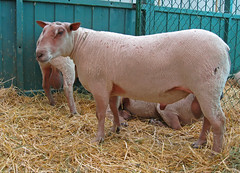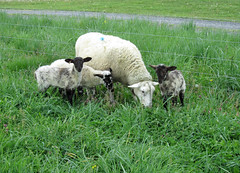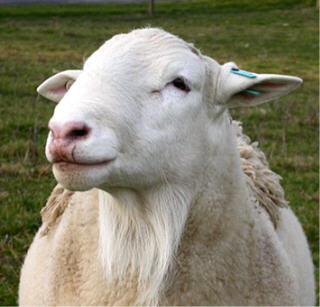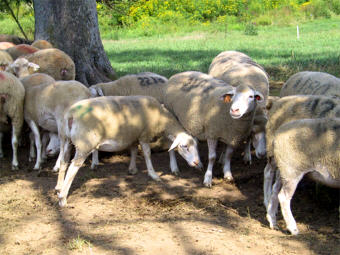One day, a guy asking me on facebook. "What is nucleus breed?". I simply replied "Pure breed". Then he asked again "Is this same as inbreeding?" then I realized maybe I gave him inaccurate answer. I had had a rough time in genetic during my sophomore years. When he asked me that question, he gave me idea to revise back basic principle of breeding system; the one I have forgotten for quite some time.
**************************************************************
Breeding system (as described in sheep breeding system)
Animal breeding is a branch of animal science that addresses the evaluation of the genetic value of domestic livestock. A breed is a group of domestic animals with a homogeneous appearance, behavior, and other characteristics that distinguish it from other animals.
1. Pure breeding
Pure-breeding is the mating of rams and ewes of the same breed or type. A purebred flock can be managed as a single flock because all ewes and rams are of the same breed. The goal of purebred sheep production is to provide superior genetics (seedstock) to the commercial sheep industry. Seedstock are marketed as rams and replacement ewes to other seedstock producers or to commercial sheep operations.

Pure bred merino sheep

Pure bred charollais ram
Inbreeding is a system of breeding in which closely related animals are mated. This includes sire to daughter, son to dam, and brother to sister. Technically, inbreeding is defined as the mating of animals more closely related than the average relationship within the breed or population concerned. The primary genetic consequence of inbreeding is to increase the frequency of pairing of similar genes.
Inbreeding is essential to the development of prepotent animals — animals that uniformly "stamp" their characteristics on their progeny. Inbreeding may also be used to uncover genes that produce abnormalities or death — genes that, in outbred herds, are generally present in low frequencies. Inbreeding is suggested for only highly qualified operators who are making an effort to stabilize important traits in a given set of animals.
In general, inbreeding results in an overall lowering in performance: vigor, disease resistance, reproductive efficiency, and survivability. It also increases the frequency of abnormalities. For example, the spread of spider lamb disease in black-faced sheep is believed to be the consequence of inbreeding.
3. Linebreeding
Linebreeding is a system of breeding in which the degree of relationship is less intense than in inbreeding and is usually directed towards keeping the offspring related to some highly prized ancestor. The degree of relationship is not closer than half-brother half-sister matings or cousin matings, etc. Line breeding is a mild form of inbreeding.
The benefit of linebreeding is the production of more consistent offspring. It also have a chance to reinforce desired characteristics and eliminate health problems one has to have a thorough knowledge of both pedigrees of both sire and dam for at least 5 generations.
Breeders can assure uniform of quality without asking the inherent danger of inbreeding. This techniques appears to be the best compromised between inbreeding and doubts between outcrossing and outbreeding.
4. Outbreeding
Out-breeding is the mating of animals of the same breed but which have no closer relationship than at least 4 to 6 generations. Outbreeding is the recommended breeding practice for most purebred sheep breeders.
5. Crossbreeding
Crossbreeding is the mating of rams and ewes of different breed compositions or types. However, it does not denote indiscriminate mixing of breeds, but rather is a systematic utilization of different breed resources to produce crossbred progeny of a specific type. Crossbreeding is used extensively in the commercial sheep industry and the majority of slaughter lambs are crossbred.
Crossbreeding offers two distinct advantages:
1)heterosis
2)breed complementarity.
Heterosis or hybrid vigor is the superiority of the crossbred offspring. Mathematically, heterosis is the difference in performance between the crossbred and the average performance of its purebred parents.
There are effects of heterosis in the crossbred offspring, crossbred dam, and crossbred ram. In general, crossbred individuals tend to be more vigorous, more fertile and grow faster than purebreds.
Effects of heterosis tend to be large for traits that are lowly heritable (e.g. reproduction) and small for traits that are highly heritable (e.g. growth, carcass, and wool). The effects of heterosis are cumulative. Heterosis can be maximized by mating crossbred ewes to a ram of another breed to produce crossbred offspring. Composite breeds such as the Katahdin and Polypay capture most of the benefits of heterosis.

ewe with crossbred lambs

Hybrid vigor

crossbred Dorper ram
The second major advantage of crossbreeding lies in the ability to utilize breed complementarity. All breeds have strengths and weaknesses. No one breed excels in all relevant traits. Thus, production can be optimized when mating systems place breeds in roles that maximize their strengths and minimize their weaknesses.
Mating Polypay ewes to Suffolk rams is an example of matching complementary strengths of breeds to optimize efficiency of a production system. This cross takes advantage of the reproductive efficiency and moderate maintenance costs of Polypay ewes while producing Suffolk-sired lambs to meet market requirements for fast-growing, heavy muscled lambs.
The efficiency of this cross would be much greater than the reciprocal mating of Suffolk ewes to Polypay rams. The latter cross would produce genetically equivalent market lambs (half Suffolk and half Polypay), but fewer lambs would be sold and production costs greatly increased due to higher feed requirements of heavy Suffolk ewes compared to Polypay ewes.
************************************************************
Crossbreeding system
There are several systematic crossbreeding systems. Terminal crossing makes maximum use of both heterosis and breed complementarity. It may utilize two, three, or four breeds, and can be as simple as crossing two pure breeds.

3-ways cross lambs
1.Terminal crossing
In terminal crossing, all of the crossbred offspring are sold and replacement ewe lambs must be purchased or produced in the flock by mating a proportion of the flock to rams of the same breed. In a three or four breed terminal crossbreeding system, crossbred ewes and crossbred rams can be utilized in the system to maximize heterosis.
2.Rotational crossing
Rotational crossing will also maintain high levels of heterosis. Rotational crossing involves alternating the use of rams of two, three, or more breeds. Ewes are mated to rams of the breed which they are least related. It works best when breeds which function acceptably as both ram and ewe breeds, are utilized.
3.Roto-terminal crossing
Roto-terminal crossing involves both terminal crossing to produce market lambs and rotational crossing to produce ewe lambs. The best ewes in the flock would comprise the nucleus flock. They would be used to produce replacement ewes. The rest of the ewes in the flock would be bred to a terminal sire to produce market lambs.
4.Grading up
Grading up denotes the repeated crossing of ewes and their female progeny to rams of a single breed, with the ultimate objective of creating a flock that is indistinguishable from purebred flocks of the ram breed. It is used when only rams of the breed of interest are available or affordable.

Grading up to Dorper
5.Composite breeds
Crossbreeding is also used to form new or "composite" breeds. Once the crossbred base population has been formed, the flock is managed as a purebred flock. This is how many new breeds are created.Many of the aforementioned crossbreeding systems are difficult to accomplish in a small flock, which may only have the option of one or two breeding groups. The purchase of replacement females would enable the use of a terminal crossing program. Alternating the use of ram and ewe breeds would maintain maternal and growth characteristics in the flock.

Polypays: A composite breed
Ps: I am not expert in genetics, references is needed to guide the detail explanations of breeding system
Sources: sheep 201; A beginner's guide to raising sheep,




















0 comments:
Post a Comment